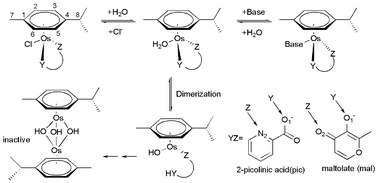Aquation and dimerization of osmium(ii) anticancer complexes: a density functional theory study†
Abstract
In this paper, the hydrolytic and aqueous solution chemistry of two half-sandwich

* Corresponding authors
a MOE Key Laboratory of Bioinorganic and Synthetic Chemistry/KLGHEI of Environment and Energy Chemistry, School of Chemistry and Chemical Engineering, Sun Yat-Sen University, Guangzhou, P. R. China
b Department of Chemistry, The University of Memphis, Memphis, Tennessee, USA
c Key Laboratory of Renewable Energy and Gas Hydrate, Guangzhou Institute of Energy Conversion, Chinese Academy of Sciences, Guangzhou, P. R. China
In this paper, the hydrolytic and aqueous solution chemistry of two half-sandwich

 Please wait while we load your content...
Something went wrong. Try again?
Please wait while we load your content...
Something went wrong. Try again?
H. Wang, N. J. D. Yonker, H. Gao, C. Tan, X. Zhang, L. Ji, C. Zhao and Z. Mao, RSC Adv., 2012, 2, 436 DOI: 10.1039/C1RA00604E
To request permission to reproduce material from this article, please go to the Copyright Clearance Center request page.
If you are an author contributing to an RSC publication, you do not need to request permission provided correct acknowledgement is given.
If you are the author of this article, you do not need to request permission to reproduce figures and diagrams provided correct acknowledgement is given. If you want to reproduce the whole article in a third-party publication (excluding your thesis/dissertation for which permission is not required) please go to the Copyright Clearance Center request page.
Read more about how to correctly acknowledge RSC content.
 Fetching data from CrossRef.
Fetching data from CrossRef.
This may take some time to load.
Loading related content
